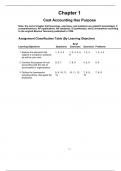Exam (elaborations)
Solutions for Cost Accounting: With Integrated Data Analytics, 1st Edition by Farmer
- Course
- Institution
Complete Solutions Manual for Cost Accounting: With Integrated Data Analytics, 1st Edition 1e by Karen Congo Farmer, Amy Fredin. Full Chapters Solutions Manual are included - Chapter 1 to 18 Cost Accounting Has Purpose 2 Refresher on Cost Terms 3 Cost Behavior and Cost Estimation 4 Cost-Volume-P...
[Show more]



